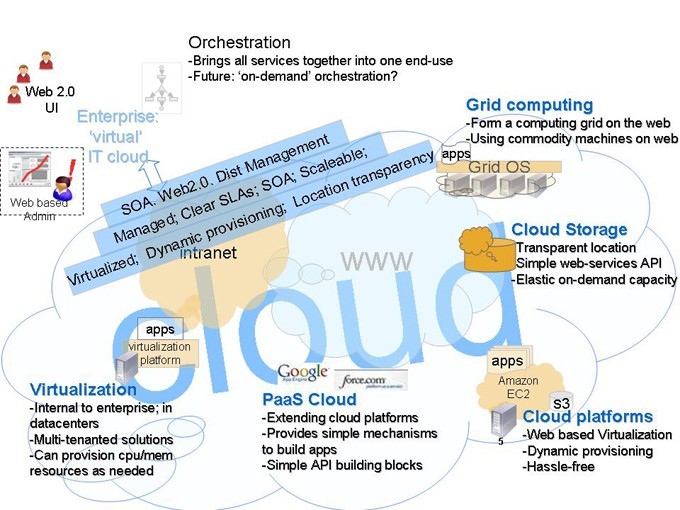Cloud Computing... It Depends on Who You Ask

What exactly is cloud computing? Lately, this is one of the most often repeated question in any discussion about the Cloud. And the answer depends on who you ask! (Personally, I think that if there are not at least three different popular definitions of a new technology, then the technology is not in its "hype" phase of the hype cycle :-) ).
Cloud is often confused to be just one of:
- Utility Computing - The on-demand resources with dynamic provision offered by virtualization platforms such as VMware, EC2 etc.
- Grid computing - Loosely coupled discreet computing nodes, that come together to form a larger computing-grid.
- SaaS - Just the notion of a software abstracted on the web is cloud to some.
- PaaS - To some, cloud is if one were to "build" the solution and then deploy it on a virtualized platform on the web.
- User centric cloud - RIA desktops that provide seamless and integrated access to information and services on the web, while still retaining a "sane" visual front to the user.
- Even Wikipedia defines it as: The majority of cloud computing infrastructure as of 2009 consists of reliable services delivered through data centers and built on servers with different levels of virtualization technologies. The services are accessible anywhere in the world, with The Cloud appearing as a single point of access for all the computing needs of consumers.
- And, I am sure there are more!
Syscon attempted to reconcile the definitions by getting no less than twenty one (!!) industry experts to define cloud. Their definitions had wide ranging defining attributes: elastic, virtualized, services over the web, multi-tenanted, pay-as-you-use, massively scalable technology enabled services, SaaS is the consumer-face of cloud computing, distributed utility grid (wow!), on-demand resources with APIs, and more!
What I see missing though is the end enterprise view. It is this view that brings all of the above (and more) together. As I see it, this is "cloud computing". A fairly abstract IT enterprise landscape. Where the biz requirement is real—with its solution made available over the web, with simple web based user access, with guaranteed SLAs on service availability and performance, with seamless integration to other information sources/services over the landscape. The exact location, platform, configuration, size and such are all abstracted from the enterprise by the solution provider. Further, the solution provider also takes care of maintaining the application (enhancements/bug fixes), managing the production environment, and managing any backend integration requirements that the client-enterprise may have - offering a complete "managed service". The enterprise needs to focus just on the biz at hand, and in defining the IT solution that is needed. The solution-service providers takes care of the rest. All of them coming together to form the enterprise "cloud" - accessed over the web, managed over the web and probably even orchestrated over the web.
The enterprise Cloud will also evolve over time. When there is just one ISV making a solution available in the above managed model, that is SaaS. If the same ISV also "builds" it on the web before making it available on the web, then that is PaaS. If the ISV just uses storage on the web, then that is cloud storage. If the same solution is deployed within the enterprise network on a virtualized platform such as VMware, then that is virtualization. If the solution is distributed across discreet computing "nodes" on the web, then that will be the computing grids. Now fast-forward a few years... If the IT landscape in an enterprise architecture is a combination of all of the above types of solution environments, then there is an opportunity for a loose "biz grid" that can bring all of these together, which in many ways is already prevalent today - the SOA infrastructure! SOA is all about discreet services that are location agnostic, with standards based description and easy access. Today's SOA environments are very very vendor dependent (that is assuming the emphasis is on the reliability and performance). Soon we may see this a reality. A vendor neutral SOA environment that will bring together all the disparate IT solutions in the enterprise, both within and on the cloud. Likewise, Web 2.0 will define the user experience that brings all of the same solutions in a seamless integrated and very-functional UI.
Below is a visual of what I'm thinking... use Comments to let me know what you think.


